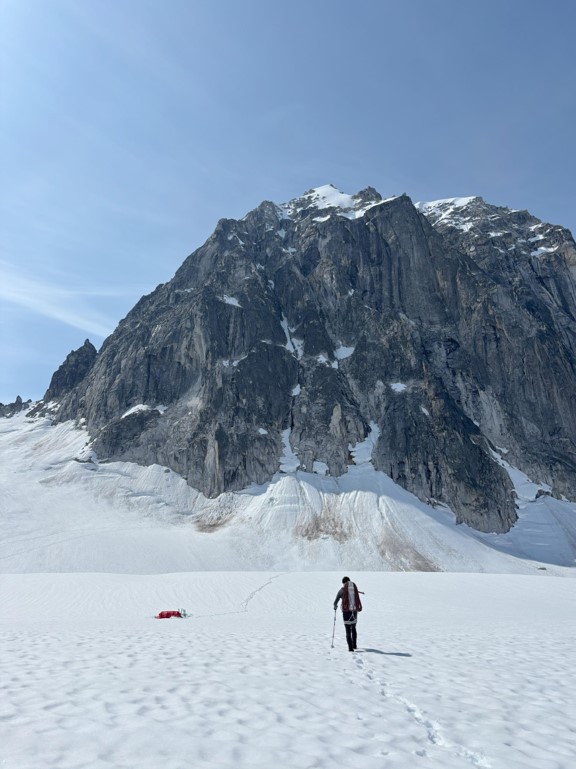
Camping below the Royal Tower with the route, Arizona Highways left of center. Photo/Scotty Barrier.
Over the Fourth of July weekend, rangers had the opportunity to conduct a climbing patrol around the Pika Glacier. Despite a relatively cool summer and increased snowfall in the Alaska Range the majority of the rock routes were snow-free and not threatened by cornice fall. Glacial conditions made for easy travel with minimal crevassing and motes that were easy to manage. Although incoming weather cut the trip short by a few days, rangers were still able to explore multiple areas and climbs around the Pika.
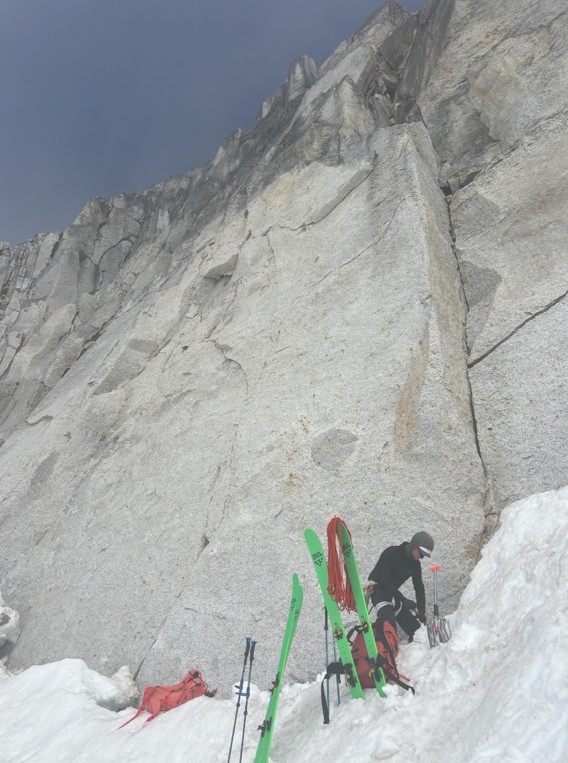
Transitioning at the base of Masters of the Mid on the Crown Jewel. Photo/Scotty Barrier.
After inserting near the airstrip, rangers set up camp and then headed up, past the Munchkin and down the Crown Glacier to check out a route on the West aspect of the Crown Jewel, known as Masters of the Mid. Although the rock quality was excellent, the supposed rappel anchors were nowhere to be found, and no natural anchors could be found. Rather than leave gear behind, the team opted to scramble across ledges and explore a new route or two instead. The dihedral below was approximately 25m of splitter, and a rappel anchor was established off a slung block.
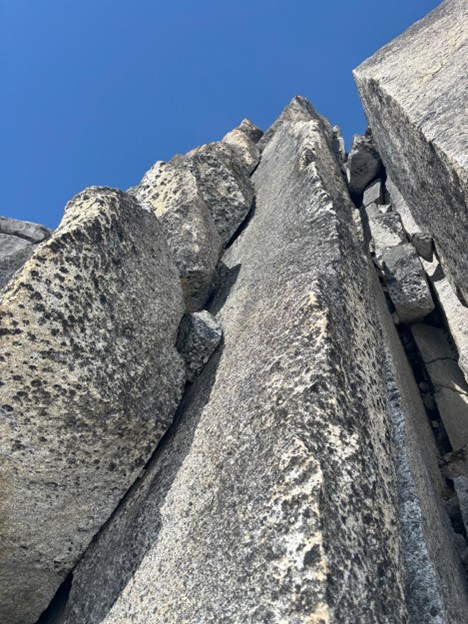
One of many unknown cracks to the south of the previous photo. Photo/Scotty Barrier.
Given the late hour of the day, good skiing and evening corn on easterly aspects was a welcome treat while dropping back onto the Pika.
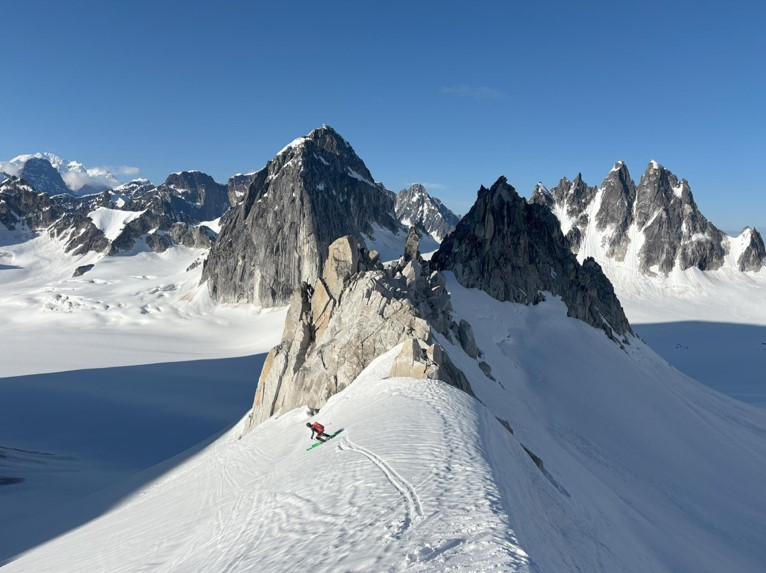 Skiing past the Munchkin, on the way back to camp on day 1. Denali, Avalanche Spire, The Hobbit’s Footstool, the Throne, and the Trolls in the background. Photo/Scotty Barrier.
Skiing past the Munchkin, on the way back to camp on day 1. Denali, Avalanche Spire, The Hobbit’s Footstool, the Throne, and the Trolls in the background. Photo/Scotty Barrier.On day two, clear weather and warm temps made for good climbing conditions on the Royal Tower. The team set their sights on the Jester, also known as Arizona Highways. The route has a few variations but goes at 5.10a/b if you take the center of the three cracks at the base of the wall. Rangers found laser-cut crack climbing nearly the entire way up the route. However, it should be noted that this route doesn’t see a ton of activity, and the majority of pitches were quite gritty with a fair bit of loose blocks and chossy scrambling between pitches. After 6 pitches of quality climbing, rangers descended the route, improved or replaced all rappel anchors, and did a fair bit of cleaning of loose blocks. 2 more pitches of technical climbing and 1,200’ of scrambling would take you to the summit. It’s worth mentioning that of nearly all the features in the immediate vicinity, this area of the Royal Tower had the highest concentration of rockfall and cratering at the base of the buttress.
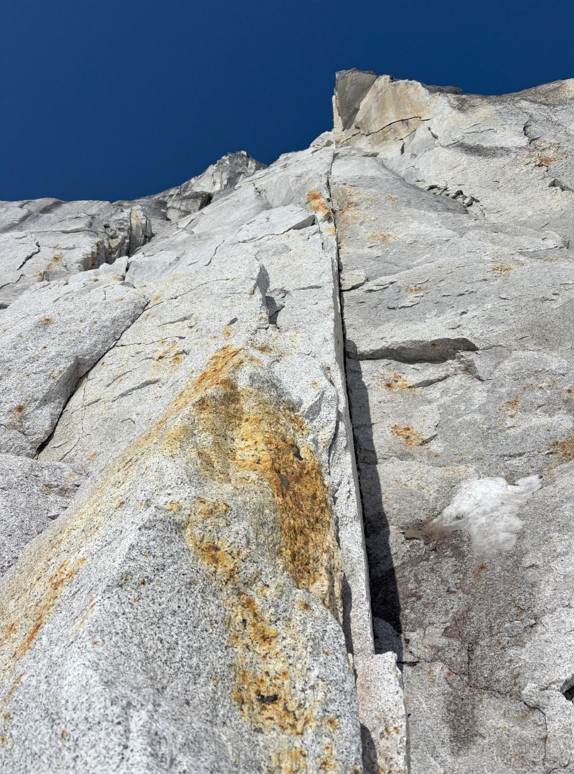 The central crack at the base of Arizona Highways. A variation to the left is a wide 3-4” crack that goes at 5.9, and the flake seen to the right is a 1-3” feature that is seen in the upper right corner, goes at 5.11. Photo/Scotty Barrier.
The central crack at the base of Arizona Highways. A variation to the left is a wide 3-4” crack that goes at 5.9, and the flake seen to the right is a 1-3” feature that is seen in the upper right corner, goes at 5.11. Photo/Scotty Barrier.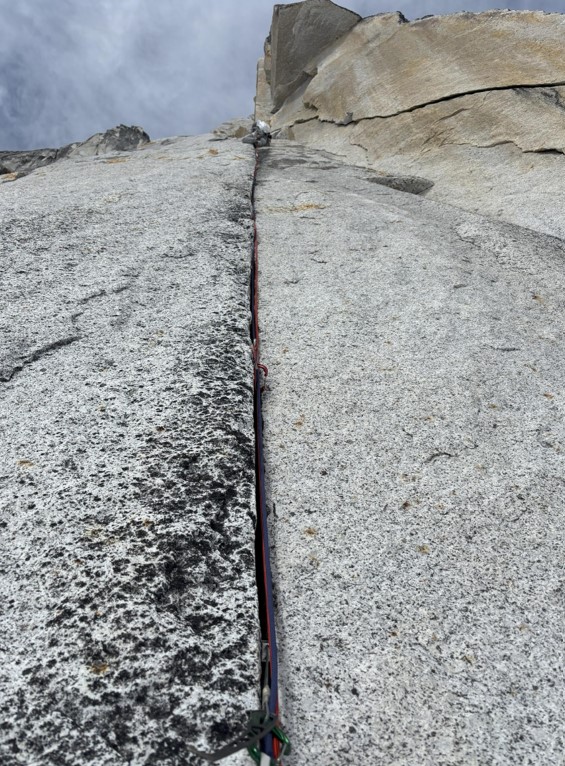 Upper section of the 5.10a crack. Multiples in the 0.5-0.75” range are helpful. Due to glacial recession, this original 1st pitch was broken into 2 rather than a full 60m+ rope stretcher. Photo/ Scotty Barrier.
Upper section of the 5.10a crack. Multiples in the 0.5-0.75” range are helpful. Due to glacial recession, this original 1st pitch was broken into 2 rather than a full 60m+ rope stretcher. Photo/ Scotty Barrier. 5.8 dihedral on the 5th pitch. Photo/Scotty Barrier.
5.8 dihedral on the 5th pitch. Photo/Scotty Barrier.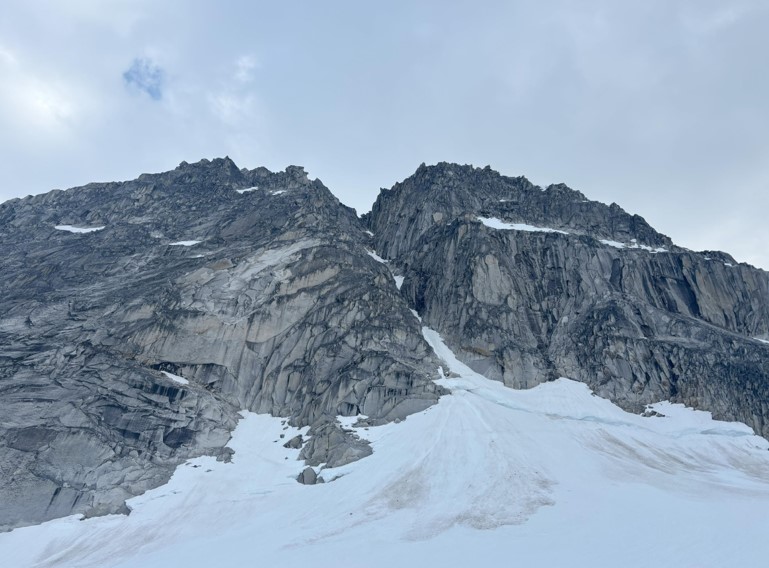 Looking up the south face of the Throne. The Lost Marsupials climbs the leftward ridgeline, just left of the central gulley. Photo/Scotty Barrier.
Looking up the south face of the Throne. The Lost Marsupials climbs the leftward ridgeline, just left of the central gulley. Photo/Scotty Barrier.Day three brought an unsettled forecast and dark clouds in the morning, but the team hoped for a window of improvement and struck off early for a shot of The Lost Marsupial on the south face of the Throne. The team was rewarded with outstanding rock quality, fun route finding, clearing skies, and engaging ridge travel to the summit. It has been reported that the Throne has some of the best rock quality along the Pika Glacier, which made for relatively secure climbing and easy route finding by simply following your nose.
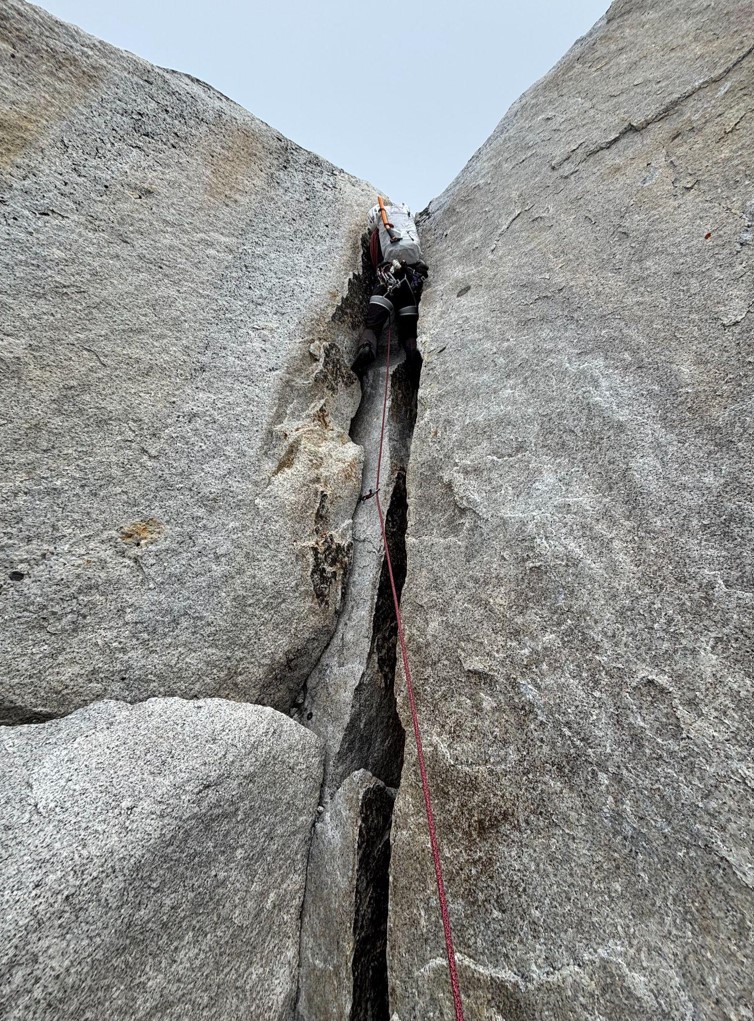 One of the many variations along the way up the Lost Marsupials route. Photo/Scotty Barrier.
One of the many variations along the way up the Lost Marsupials route. Photo/Scotty Barrier.Along the route, many variations exist, and route finding is relatively straightforward. The route begins on the rightward ramps in the center of the route photo and takes you to the upper skyline. From there, fun and engaging ridgeline scrambling on snow and rock eventually takes you to the summit. High, late-season snowloading generated large cornices on leeward aspects and made for interesting ridge travel. Rangers found this final section of the route to be the most engaging and interesting, given the proximity of large cornices, the blocky scrambling, and exposure at times.
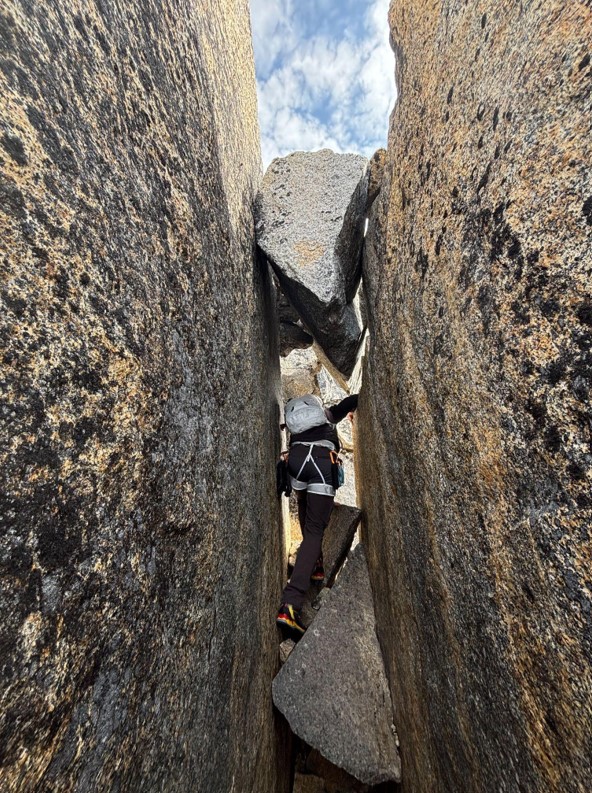
A chockstone chimney variation along the final ridgeline that skirted overhung snow to the north. Photo/Scotty Barrier.
After topping out and a quick snack, rangers quickly backtracked the ridgeline and began the rappels and descent back down the route. Although all of the terrain along the ridgeline was 3rd and 4th class, bringing a rope for should belays or rappels should be a consideration.

One of the many blocks to navigate along the final ridge. Photo/Scotty Barrier.
Although old tat and rappel anchors are scattered across the route, rangers did their best to remove old or unsafe anchors and improved or replaced the most logical and robust rappel anchors along the route. Eight rappels and a few short sections of descending 3rd-class terrain gets you back across the bergschrund and to the base of the route.
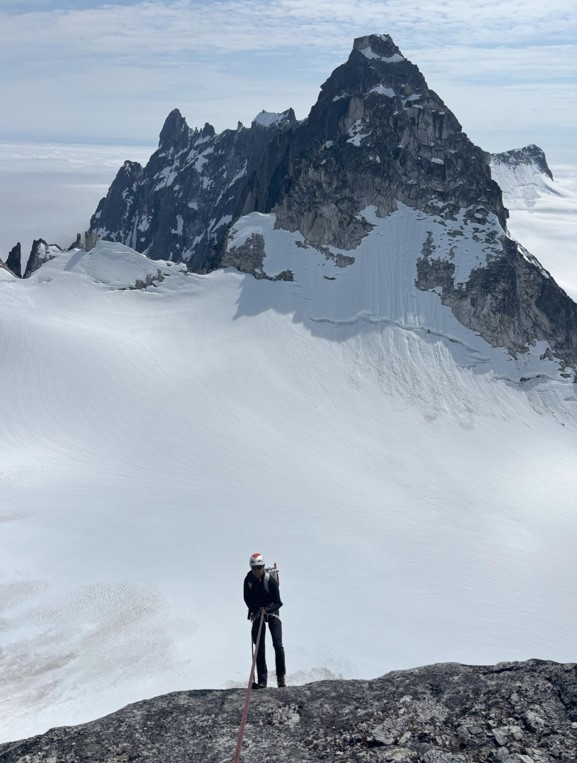 Nearing the last few rappels to the base of the route. The North and Middle Trolls are seen in the background. Photo/Scotty Barrier.
Nearing the last few rappels to the base of the route. The North and Middle Trolls are seen in the background. Photo/Scotty Barrier.For anyone who enjoys alpine rock climbing above glaciers, the Pika region should be on their radar. Although there is a fair bit of choss and loose rock around the area, there are also some quality routes and splitter cracks to hop on. From moderate, classic ridge scrambling to splitter hand cracks, the region has it all. Low elevation, short approaches, easy glacier travel, and bountiful skiing and climbing opportunities make the Pika a great destination for a first-time Alaska Range visitor as well as a seasoned veteran. NPS rangers hope to be back, sooner rather than later.
